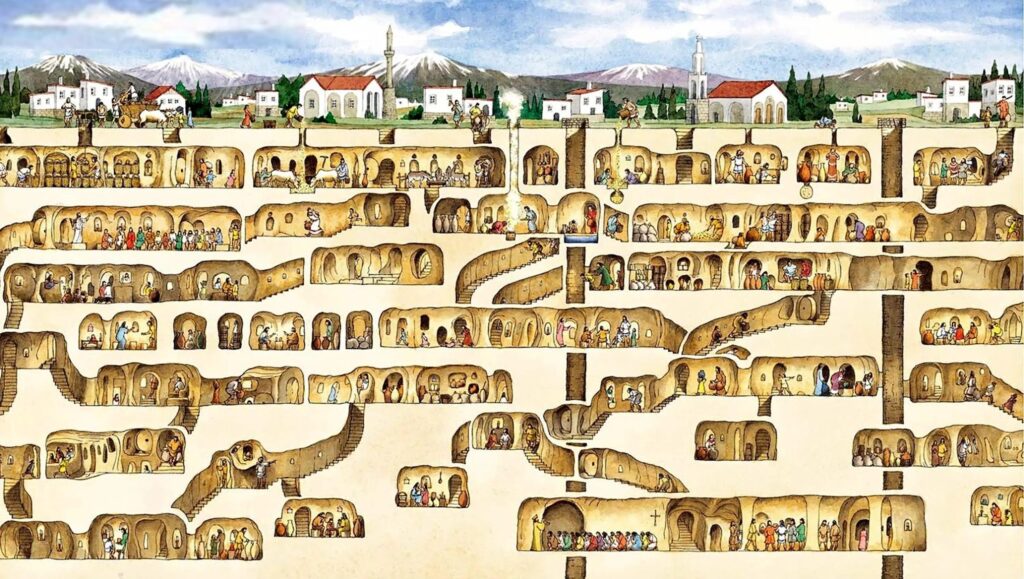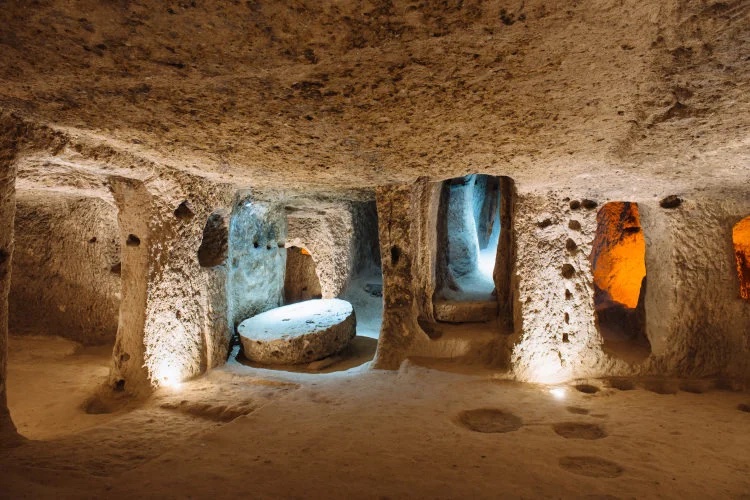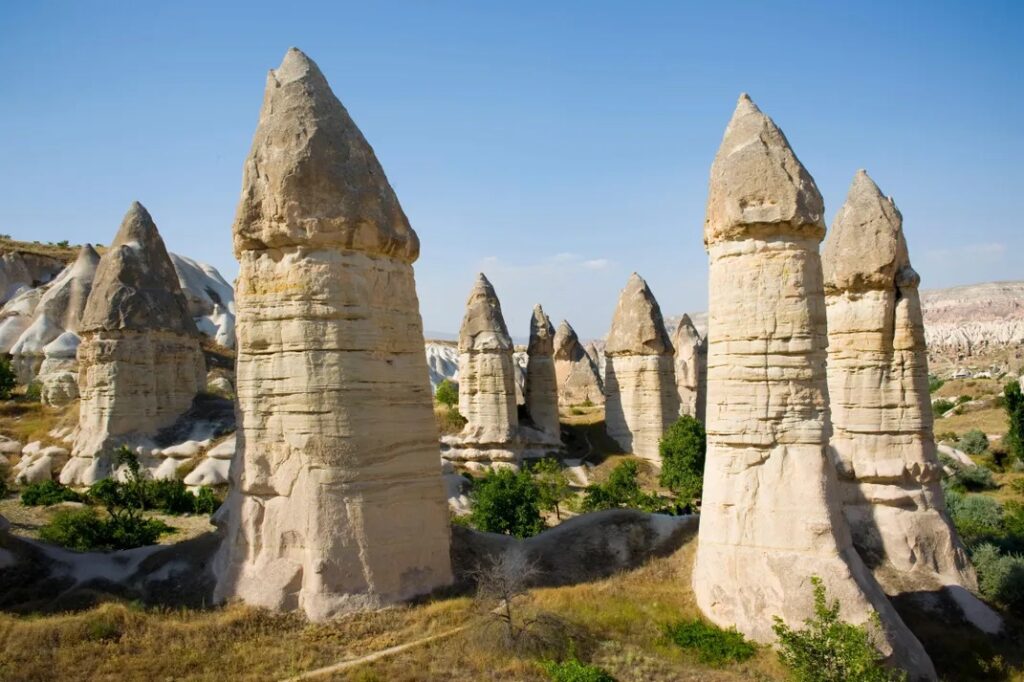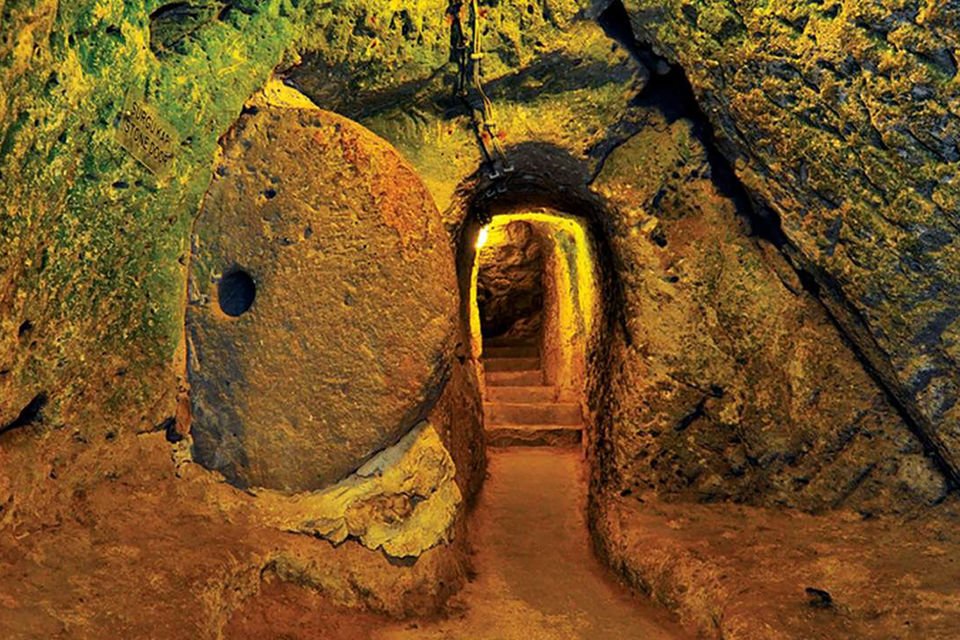
The ancient underground city of Derinkuyu, located in present day Turkey, was discovered in 1963 by a man renovating his basement. This massive network of tunnels and rooms extends 280 feet into the earth and contains up to 18 stories. Archaeologists estimate that the city could house 20,000 people. But why was such a large city constructed beneath the earth’s surface? And who could have dug it? And when? And why was it abandoned? Questions like these still plague archaeologists and some of their answers remain undetermined.
Who could have built such an extensive underground matrix, and when? Archaeologists still aren’t sure. Some christian iconography suggests that they were built by early christians in the first couple centuries CE. Many archaeologists claim that the tunnels were dug before that, by the Phrygians around 700 BCE. However, some believe Derinkuyu could date back to 2000 BCE, built by the Hittites, who dominated the area at the time. If it was the Hittites who built the city, it is certain that they were not the last to reside there. Derinkuyu was likely shared by several different cultures since its original construction. For instance, there is strong evidence to suggest that Christians from the 6th to the 10th century CE made additions to the tunnel network. Determining exactly what cultures inhabited the tunnels is nearly impossible, unfortunately, as any artifacts or iconography to indicate their identity have been replaced with each new community to move in.

Derinkuyu is located in the historical Cappadocia region, covered in a rocky landscape full of “fairy chimneys”. These stunning natural rock formations are the result of erosion of a type of stone called tuff, which is ironically very soft and ideal for digging. Whoever it was that constructed the underground city had highly advanced rock mining skills, as the soft rock is at high risk of caving in, yet there is no evidence that any rooms ever did. When closed off from the Earth’s surface, the tunnels were ventilated by over 15,000 chimneys. Each was only about 4-5 inches wide, but supplied adequate ventilation to all levels of the city. The upper levels served mainly as the living quarters, as they were the best ventilated. Lower levels were used more for storage as well as a dungeon. All the levels in between contained churches, a convent, a room for wine press, and even housed domestic animals. Some shafts extended even further below the lowest levels, and doubled as wells, which were still being used by modern locals of the area before Derinkuyu’s rediscovery. The name darin kuyu actually translates from Turkish to “deep well”.
For an informational tour of the tunnels, watch this video: https://www.youtube.com/watch?v=7_7uDG-VJZE

Why was such a large settlement built entirely underground? Most archaeologists share the opinion that Derinkuyu was built as a refuge, whether from enemy armies or the extreme seasons. Enormous rolling stones used to cover the ground level entrances to the city serve as evidence for these claims. Underground, temperatures remained constant and could be regulated, and crops could be stored and protected from the weather. Regardless of the original reason for its construction, Derinkuyu was undoubtedly used as refuge for the local population while the Byzantines and Arabs were at war between the 8th and 12th centuries CE, as well as throughout the Mongol raids of the 14th century. There is even some linguistic evidence in the tunnels that a local Greek population sought shelter there occasionally. After the Greco-Turkish war ended in 1922, the Cappadocian Greeks left the area, taking with them the knowledge that the city, which they had named Malakopia, meaning “soft” in Greek, ever existed beneath the ground.

Derinkuyu is not alone beneath the Turkish landscape. Hundreds of subterranean dwellings have been discovered and explored around the area. Until recently, none came close to the grandeur of Derinkuyu. But in 2014, another underground city was discovered nearby in Nevsehir, which may rival Derinkuyu’s impressive size. Though it has yet to be fully explored, seismic surveys indicate that this city may extend as deep as 370 feet, almost 100 feet deeper than Derinkuyu, and contain almost five million square feet. It was similarly built, containing living spaces, kitchens, churches, linseed presses to produce oil for lighting. Artifacts such as grindstones, ceramics, and crosses suggest that this city was used in the Byzantine era and through the Ottoman conquest. However, though we know the Byzantines inhabited the site, we cannot know for sure that they were the people to originally construct it. Questions of who really constructed these massive underground dwellings and when remain unanswered and up to interpretation.
For information on more subterranean cities in Turkey, check out this website:
The mystery of Derinkuyu’s original construction illuminates a very important aspect of archaeology. While artifacts found at a site may provide reason to believe that their owners did reside there, they do not always prove that their owners were the ones to construct the site as a whole. Throughout human history, property has been passed on from culture to culture. Countless cities have been abandoned by one culture and adopted by another. Countless cities have been captured and reclaimed. Sometimes, we find evidence of the entire lineage of cultures to inhabit these places. However, often, traces of a culture’s presence can be wiped away by time and those who followed. This only emphasizes the fact that nothing in archaeology is certain and there are some questions which have been lost to time and can never be answered.
References:
“Derinkuyu: Mysterious Underground City in Turkey Found in Man’s Basement.” Big Think, June 30, 2022. https://bigthink.com/strange-maps/derinkuyu-underground-city/.
Pinkowski, Jennifer. “Massive Underground City Found in Cappadocia Region of Turkey.” Adventure, May 4, 2021. https://www.nationalgeographic.com/adventure/article/150325-underground-city-cappadocia-turkey-archaeology.

What were the measures and processes applied to turn this basement renovation project into an archaeological site? Do you think these endeavors are still applicable to the archaeological discourse in the present day?